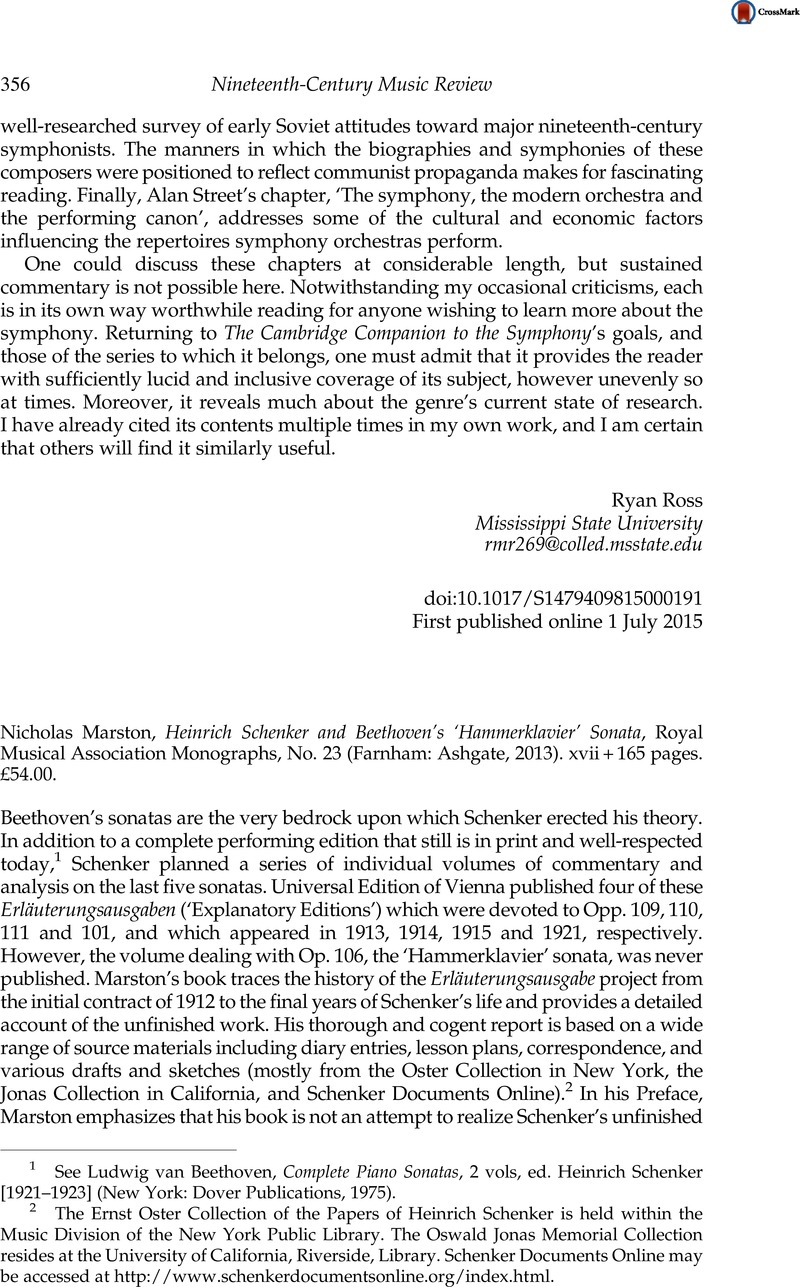No CrossRef data available.
Published online by Cambridge University Press: 09 July 2015

1 See van Beethoven, Ludwig, Complete Piano Sonatas, 2 vols, ed. Heinrich Schenker [1921–1923] (New York: Dover Publications, 1975)Google Scholar.
2 The Ernst Oster Collection of the Papers of Heinrich Schenker is held within the Music Division of the New York Public Library. The Oswald Jonas Memorial Collection resides at the University of California, Riverside, Library. Schenker Documents Online may be accessed at http://www.schenkerdocumentsonline.org/index.html.
3 For other distinguished contributions, see Marston, Nicholas, ‘Approaching the Sketches for Beethoven’s Hammerklavier Sonata’, Journal of the American Musicological Society 44/3 (1991): 404–450CrossRefGoogle Scholar, and Marston, Nicholas, ‘From A to B: The History of an Idea in Beethoven’s Hammerklavier Sonata’, Beethoven Forum 6 (1997): 97–127Google Scholar, to name but two.
4 Schenker, Heinrich, Harmony, , ed. and Jonas, ann. Oswald, trans. Elisabeth Mann Borgese (Chicago and London: University of Chicago Press [1906] 1954)Google Scholar.
5 Schenker, Heinrich, Free Composition (Der freie Satz) [1935], trans. and ed. Ernst Oster (New York and London: Longman, 1979)Google Scholar.
6 See Schenker, Heinrich, Der Tonwille, 2 vols [1921–24], ed. William Drabkin (Oxford and New York: Oxford University Press, 2004, 2005)Google Scholar. Marston also refers readers to Bent, Ian, ‘“That Bright New Light”: Schenker, Universal Edition, and the Origins of the Erläuterung Series, 1901–1910’, Journal of the American Musicological Society 58/1 (2005): 69–138CrossRefGoogle Scholar, for additional information about the project.
7 See Schenker, Heinrich, The Masterwork in Music, 3 vols [1925, 1926, 1930], ed. William Drabkin (Cambridge and New York: Cambridge University Press, 1994, 1996, 1997)Google Scholar.
8 David Beach provides transcriptions and alternative readings for Schenker’s analyses of the Prelude, Allemande, Corrente, Sarabande, Menuets I and II and Gigue from the B-flat Partita; see Beach, David, ‘Bach’s Partita No. 1 in B-flat, BWV 825: Schenker’s Unpublished Sketches with Commentary and Alternative Readings’, Music Theory Spectrum 30/1 (2008): 1–34CrossRefGoogle Scholar. The fact that Schenker posited octave-line readings for most of these movements, in spite of differences in their ‘outer forms’ is highly suggestive. See also Smyth, David, ‘Schenker’s Octave Lines Reconsidered’, Journal of Music Theory 43/1 (1999): 101–133CrossRefGoogle Scholar, for more about Schenker’s octave lines. On other late Beethoven works in B-flat, see Lambert, Sterling, ‘Beethoven in B-flat: Op. 130 and the Hammerklavier’, Journal of Musicology 25/4 (2008): 434–472CrossRefGoogle Scholar.
9 See Cohn, Richard, ‘Uncanny Resemblances: Tonal Signification in the Freudian Age’, Journal of the American Musicological Society 57/2 (2004): 285–323CrossRefGoogle Scholar, and Cohn, Richard, Audacious Euphony: Chromaticism and the Triad’s Second Nature (Oxford and New York: Oxford University Press, 2012)CrossRefGoogle Scholar. In the opening pages of the latter, Cohn explores the juxtaposition of B-flat major and F-sharp minor in the recapitulation of Schubert’s Sonata in B-flat major, D. 960, but does not mention Beethoven’s Op. 106.
10 See Rosen, Charles, The Classical Style: Haydn, Mozart, Beethoven (New York: Viking Press 1971), pp. 404–434Google Scholar. More than half of Rosen’s chapter on Beethoven is devoted to an extensive discussion of Op. 106, replete with references to the importance of ascending and descending thirds.
11 See Marston, Nicholas, ‘“The Development of Schenker’s Concept of Interruption’, Music Analysis 32/3 (2013): 332–362Google Scholar, for a provocative account of Schenker’s seeming ambivalence concerning interruption.
12 See Schenker, , Free Composition, p. 144Google Scholar.